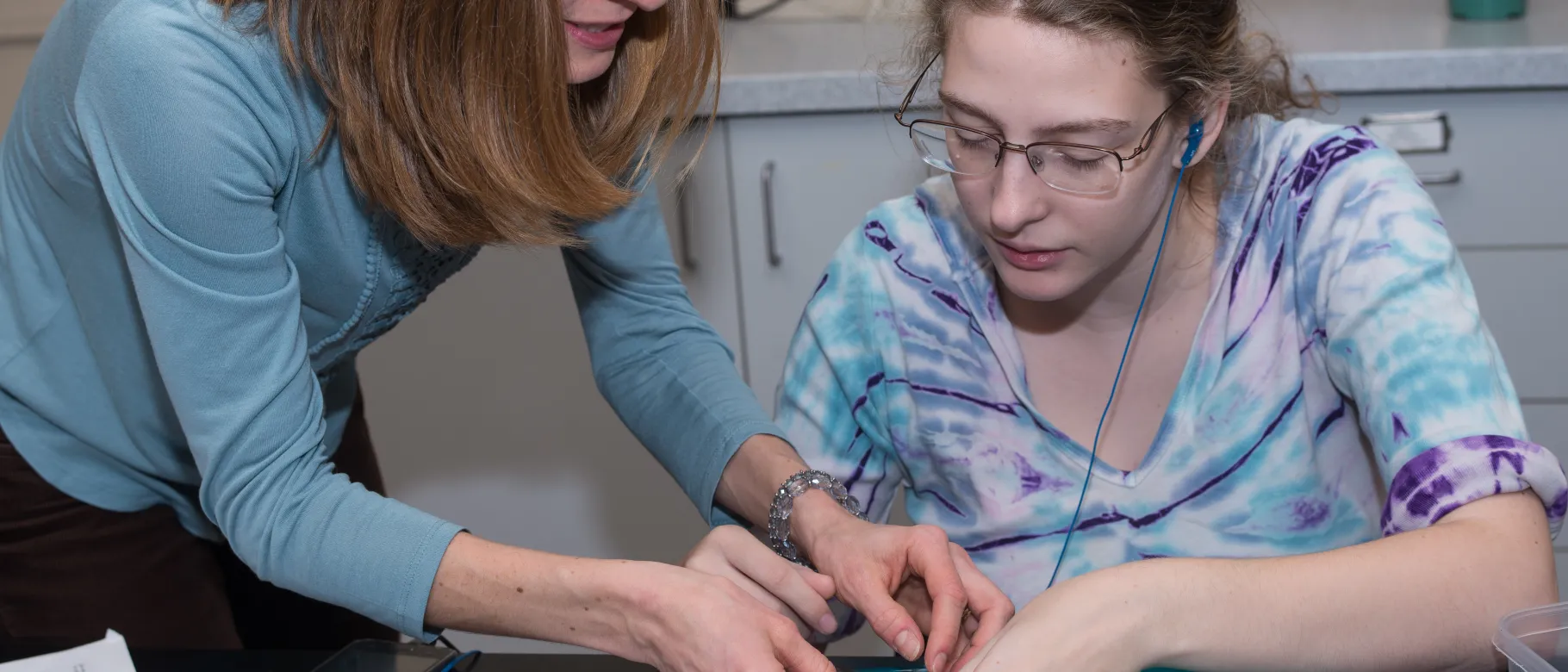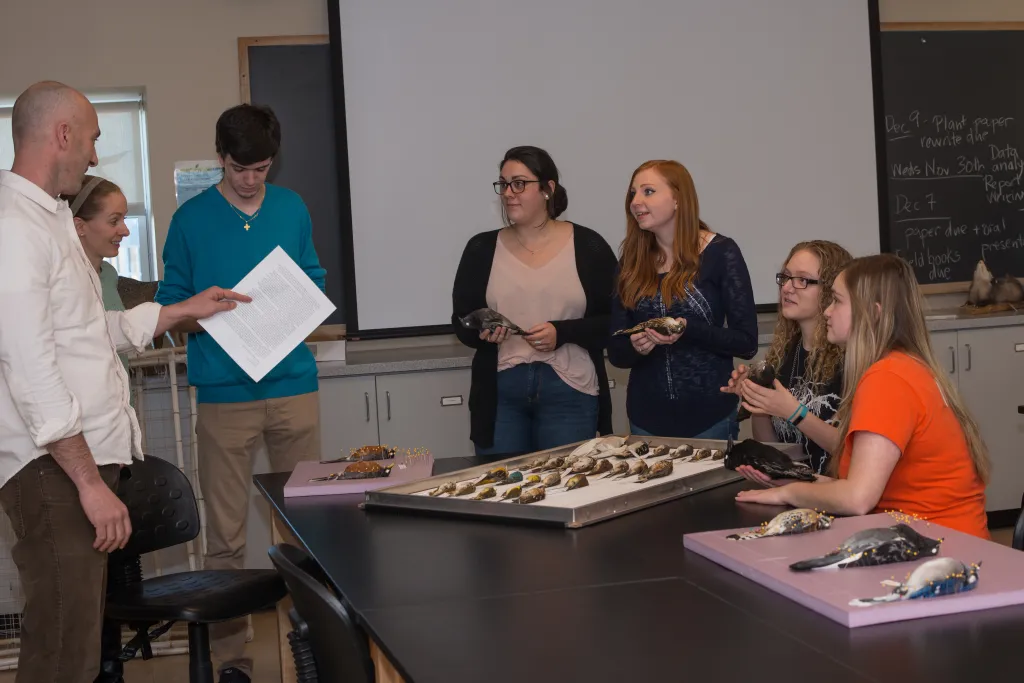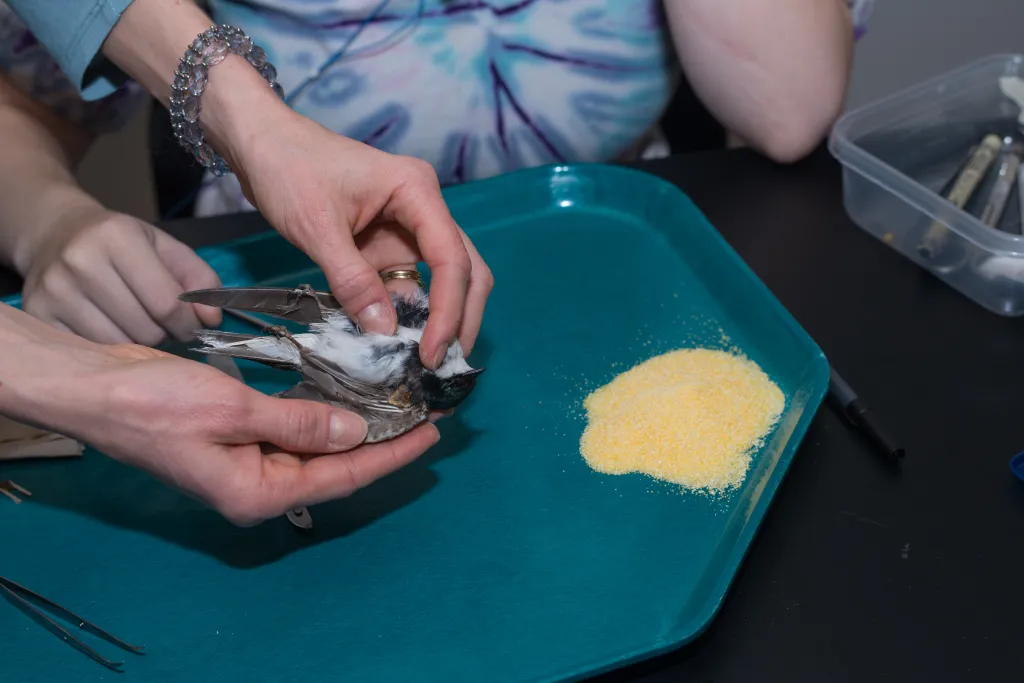Honoring wildlife through preservation: UNE launches museum specimen preparation class

In the lab in the Environmental Sciences wing of Decary Hall, students are quietly dissecting tiny birds, small enough to fit in the palms of their hands. Jeremy Lessard is carefully working to remove the skin from a Cedar Waxwing. The process seems second nature to him, despite the fact that he only learned to do it a few months ago. “I really wanted to see birds up close,” he says. “I’m an environmental science major and most of my observation has been kind of far away.” The unique aspect of this course is that it is entirely lab-based. “I am enjoying the fact that I can learn by my hands rather than worksheets, books, papers, and slideshows,” says environmental studies major, Christina Barton.
A shared interest in wildlife is what drew all of these students to a new class at the University of New England, “Bird Museum Specimen Preparation.” Associate Professor of Environmental Studies, Noah Perlut, Ph.D., always wanted UNE to have a museum-quality ornithology collection. He raised the funds for a museum specimen case, but he needed someone to prepare the specimens. He found the solution during a conversation with Lena Moser, M.A., M.S., of the Student Academic Success Center. During her undergraduate years at Cornell University, Moser worked as a curatorial assistant at the Cornell Museum of Vertebrates, and she was eager to teach others the skills necessary to prepare specimens. “What I like to tell students is, not only is this a science, it’s also an art,” Moser explains. “We show respect and honor for the bird’s life trying to create the most beautiful and professional skin possible, with as much data as possible that can be used for future research.”
According to Moser, a specimen is only as valuable as the tag attached to it with the various data points collected during the process of preparing the skin. As the students work on the birds, they study the inner workings of the body, documenting observations such as length, weight, bill measurements, wing length, fat content, stomach contents and reproductive organs. “Every piece of data gives you an index of how this bird was doing at that point in time, and when you have a certain amount of data points, you can start paying attention to certain trends that arise about population dynamics and even taxonomy and evolution,” Moser says.
The students spent the majority of the fall semester of 2016 preparing larger birds, which are easier to work with. Those specimens are now on display in the Ketchum Library. As they finish the semester, the students have advanced to smaller birds. Senior Jessica Kane has a special connection to the Gray Catbird she is working on. As she was driving home from class one day, she saw the bird on the side of the road. “I assumed it was hit by a car, and now that I’m skinning it, I’m actually seeing those injuries.” Kane says that before taking this class, she never thought about where the birds come from or who does the work of specimen preparation in museums. “Throughout the course of this semester, we’ve been doing a lot of reading about why specimen collection is so important and why this work can really contribute to education and research in the future,” she says.
Aside from environmental science students, Moser hopes to attract students from other disciplines to the class, particularly those studying anatomy or pursuing dentistry or surgery. She says this skill set could give any student an edge in the future due to the fine dissection skills and attention to detail that are required. “Even though the students in this class have different research interests and hopes and dreams, they have all said that learning to prepare specimens is helping them hone acute awareness of detail, as well as a connection to museum work which could be useful for their careers.” But it’s not just about building a resume. Jessica Kane says with this class comes a much larger lesson about the human impact on our delicate ecosystem. “To be able to hold this bird and learn about where it came from, what it’s doing here in Maine, what happened before it died… this class is really helping me think about human impacts on animal populations. This bird didn’t have to get hit by a car, but it clearly did. This just makes it a lot more personal.”
Moser hopes to offer the class every year at UNE. Students spend the Fall semester actively learning the skills behind bird specimen preparation and reading articles related to bird anatomy and physiology. In the Spring, students work independently at their own pace to create as many skins as they can for the ornithology collection. Interested students are encouraged to get in touch with Lena Moser via email at lmoser1@une.edu.
To learn more about the University of New England’s College of Arts and Sciences, visit www.une.edu/cas
To apply, visit www.une.edu/admissions

